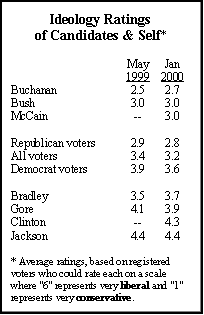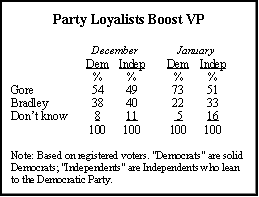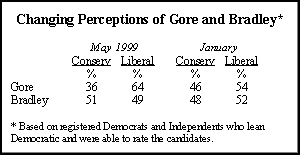Introduction and Summary
 With the start of the new year, the presidential campaign has begun in earnest for many Americans. More people are paying attention now than in the fall, and the back and forth between candidates has started to change voter perceptions. In particular, Al Gore has begun to redefine himself and challenger Bill Bradley to Democrats across the nation. Fewer voters see the vice president as very liberal than did so in May, and fewer consider Bradley as right of center. In turn, Gore’s margin of support over Bradley, which declined throughout the fall, has expanded significantly. He now holds a gaping 68% to 24% lead over his only rival for the Democratic nomination.
With the start of the new year, the presidential campaign has begun in earnest for many Americans. More people are paying attention now than in the fall, and the back and forth between candidates has started to change voter perceptions. In particular, Al Gore has begun to redefine himself and challenger Bill Bradley to Democrats across the nation. Fewer voters see the vice president as very liberal than did so in May, and fewer consider Bradley as right of center. In turn, Gore’s margin of support over Bradley, which declined throughout the fall, has expanded significantly. He now holds a gaping 68% to 24% lead over his only rival for the Democratic nomination.
The shift mirrors a Newsweek poll in New Hampshire (conducted Jan. 12-14) showing the vice president retaking the lead from Bradley among likely Democratic voters in that early primary state. But other polls taken there at about the same time find the former New Jersey senator ahead or the race even. Projected turnout among Independents accounts for some of these differences and may be decisive in the New Hampshire primary. (See p. 9)
The latest nationwide survey by the Pew Research Center, conducted Jan. 12-16, finds fewer Americans than in May rating Gore as very liberal (38% vs. 45%) and not as many viewing Bradley as right of center (45% vs. 54%). On the Republican side, Texas Governor George W. Bush continues to be seen as a conservative, but of the moderate variety. John McCain, Bush’s leading rival, is judged about the same. The current survey shows that Bush has blunted McCain’s rise in the national polls. Bush now leads the Arizona senator 69% to 17% — a slightly larger advantage than he held in December (64%-17%).
The poll finds Bush continuing to lead Gore in a general election test question, even when Pat Buchanan is included as the candidate for the Reform Party. Among all registered voters Bush leads Gore 51% to 39% with Buchanan getting just 4% — less than half of what he achieved (10%) in a September survey.
Voter interest in, and knowledge of, the presidential campaign has increased since September. More people can identify the candidates without prompting and the number paying attention to campaign news has begun to inch up. In fact, a greater percentage are now following campaign news than in either January 1996 or January 1992.
Gore’s Rally
 Gore has widened his lead over Bradley in part by shoring up support among the most loyal Democratic voters. In December, Gore had the support of just over half of strong Democrats (54%). Today, nearly three-in-four (73%) support the vice president over Bradley, and Bradley’s support among Independents who lean Democratic has fallen slightly as well.
Gore has widened his lead over Bradley in part by shoring up support among the most loyal Democratic voters. In December, Gore had the support of just over half of strong Democrats (54%). Today, nearly three-in-four (73%) support the vice president over Bradley, and Bradley’s support among Independents who lean Democratic has fallen slightly as well.
Gore has also made big gains among men and older voters. Among Democratic voters, men now prefer Gore over Bradley by a margin of 72%-23%. Those age 50 and older opt for Gore by an even wider margin — 70%-19%. In December each of these groups divided more evenly (men preferred Gore to Bradley by 53%-42%; older voters opted for Gore, 52%-40%). At the same time, men and older voters — regardless of their party affiliation — have dramatically changed their perceptions of the two Democratic candidates. Overall, men are much more likely to view Bradley as a liberal now than was the case in May. Similarly, voters age 50 and older are less likely to view Gore as a liberal.
Over the course of the campaign, Gore has come to be seen less as a liberal and more as a moderate among the general public and among Democratic voters. But not Bradley who, if anything, is seen as slightly more liberal. In May 1999, fully 67% of all voters and 64% of Democrats viewed Gore as left of center ideologically. Today, 60% of all voters and 54% of Democrats see him this way. Fully 46% of Democratic voters now view Gore as right of center — up from 36% in May.
 As Bradley has become better known to voters, his image as a moderate has faded somewhat. In May, only 57% of voters knew enough about Bradley to rate him. Those able to rate the former NBA star were as likely to view him as right of center politically as they were to view him left of center. Today, voters are more aware of Bradley (72% could rate him this month) and they are more likely to view him as liberal-leaning (55%) rather than conservative (45%). Democratic voters follow a similar pattern — 52% place him left of center, 48% put him on the right.
As Bradley has become better known to voters, his image as a moderate has faded somewhat. In May, only 57% of voters knew enough about Bradley to rate him. Those able to rate the former NBA star were as likely to view him as right of center politically as they were to view him left of center. Today, voters are more aware of Bradley (72% could rate him this month) and they are more likely to view him as liberal-leaning (55%) rather than conservative (45%). Democratic voters follow a similar pattern — 52% place him left of center, 48% put him on the right.
McCain Stalls
There has been very little change over the last month in the GOP nomination race. Bush continues to dominate the field, and McCain, his closest rival, has still failed to penetrate on the national level, which is underscored by Bush’s 4:1 advantage (69%-17%) among Republicans and GOP-leaning voters. But the Arizona senator continues to be an attractive alternative to Bush. Nearly one-third of GOP voters (31%) say he is their second choice. In addition, McCain is more popular among Independents who lean Republican than he is among party stalwarts — 25% vs. 15%, respectively say he is their first choice. Bush, on the other hand, draws more strength from Republicans than from Independent leaners (73% vs. 55% first choice).
Perceptions of Bush have changed very little over the course of the campaign. As was the case in May, Republican voters are as likely to characterize the Texas governor as a moderate as they are to call him a conservative. Roughly four-in-ten place Bush on the far right end of the ideological scale; a similar number place him squarely in the middle. Nonetheless, McCain is seen as the clear moderate in the GOP field. Fully 60% of GOP voters view McCain as a political moderate; half as many see him as a conservative.
Overall, voters place themselves closer to Bush and McCain on the ideological scale than either Gore or Bradley. Interestingly, Clinton is perceived as much more liberal than Gore. Fully 29% of Americans give Clinton the most liberal rating, compared to only 16% who rate Gore that way.
Buchanan Below 5%
 If Pat Buchanan becomes the Reform Party nominee, he’ll have to gain a lot of ground to reach the 15% threshold to be eligible to participate in debates with the major party nominees. In a hypothetical match-up with Gore and Bush, Buchanan draws only 4% of the vote, down from 10% in September. Even among Independent voters, Buchanan draws only 9%.
If Pat Buchanan becomes the Reform Party nominee, he’ll have to gain a lot of ground to reach the 15% threshold to be eligible to participate in debates with the major party nominees. In a hypothetical match-up with Gore and Bush, Buchanan draws only 4% of the vote, down from 10% in September. Even among Independent voters, Buchanan draws only 9%.
In spite of Gore’s gains against Bradley, Bush continues to best the vice president in the general election match-up. Currently, 51% of voters would choose Bush in a three-way match-up with Gore and Buchanan; 39% prefer the vice president.
Gore continues to lag behind Bush among most major demographic groups. The only groups to give Gore majority support are non-whites (71%) and urban dwellers (55%). Gore’s problems with women persist; they prefer Bush by a margin of 49% to 42%. In addition, more Democrats than Republicans are crossing party lines in the general election vote. At this point, Gore can count on the votes of 79% of Democrats in a three-way race with Bush and Buchanan. Bush receives the support of 89% of Republicans. Similarly, fully 21% of those who voted for Clinton in 1996 say they’ll vote for Bush in 2000.


